The 8000 BC Tower of Jericho at the site of Tell es-Sultan, 2009.
Jericho is famous both to prehistorians and Biblical scholars. It is likely the oldest continuously inhabited permanent settlement in the world, known for ancient astronomical observatories, plastered skulls, and impressive walls, and it is these walls that the city is probably most famous for. The walls of Jericho are the subject of much discussion and research due to their importance for evaluating the historicity of the Biblical narrative of the ancient Israelite invasion of Canaan.

Before the Bible
Early archaeological work was done on Jericho in the late 1950s by investigators, such as Dame Kathleen Kenyon. Among many other things, they found evidence of walls and a city that had been attacked. This has made Jericho a place of great importance for those interested in Biblical studies.
The earliest evidence of settlement comes from 12,000 years ago when hunter-gatherers settled in the area. Although they were hunter-gatherers, the area seems to have been abundant enough that they were able to live a sedentary lifestyle. They lived in oval stone structures that were partially underground. By about 10,500 years ago, or around 8,500 BC, the people of Jericho had adopted agriculture and Jericho had become a major Neolithic settlement engaging in long distance trade. It was during this time that the famous tower of Jericho was built.
The tower of Jericho was originally discovered by Dame Kathleen Kenyon who suggested that it might have formed part of the original fortification of the town. Modern archaeologists have suggested that it is an ancient astronomical observatory. Within the tower is a staircase that leads to a position where, on what was the summer solstice at the time, the sun could be seen setting behind Mount Quruntul within the Judaean mountains.
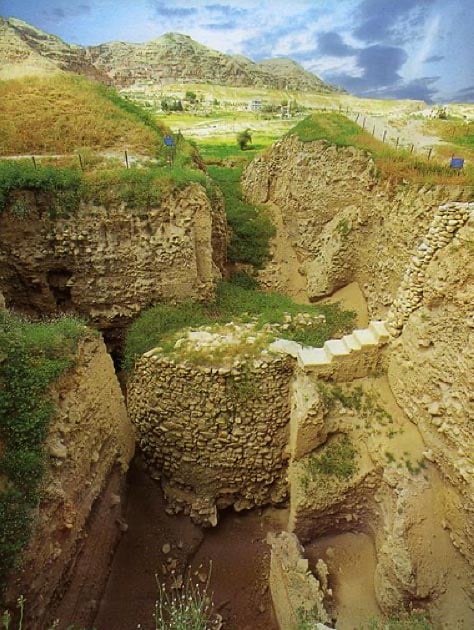
The 8000 BC Tower of Jericho at the site of Tell es-Sultan, 2009. (Salamandra123 /CC BY-SA 3.0)
In addition to the tower, mysterious plastered skulls have been found, where the skulls were taken out of their graves and given plastered facial features and shell eyes. They are believed to be related to ancestor worship.
- ARCHAEOLOGISTS CLAIM TO HAVE DISCOVERED THE LOCATION OF THE BIBLICAL CITY OF SODOM
- ARCHAEOLOGISTS UNCOVER THE GATE OF JESUS’ FEEDING MIRACLE CITY
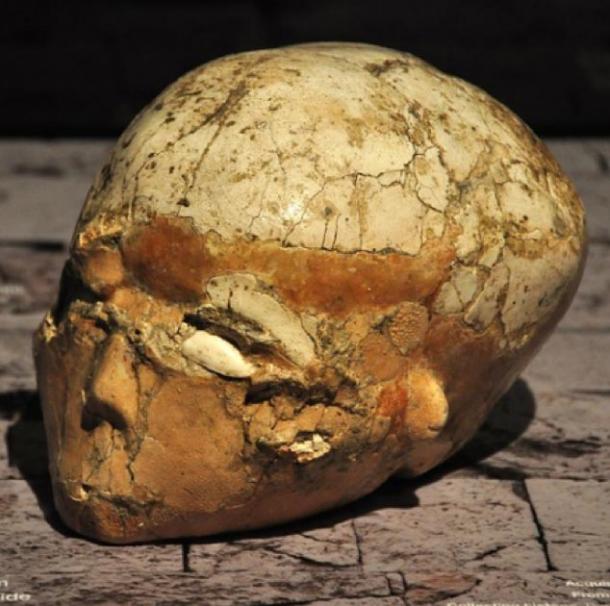
Plastered Skull from Jericho from 7,000 BC discovered by Dame Kathleen Kenyon, 1957. (Merryjack, CC BY-NC-SA 2.0)
By about 7,000 BC, there was a cultural shift where the population in Jericho was reduced and architectural styles changed from round to rectangular houses. Jericho continued to exist as a small village but did not become a large settlement again until around 3,000 BC. After 3,000 BC, extensive fortifications, consisting of walls and towers, were constructed around Jericho. Large cemeteries were also built. Around 2300 BC, Jericho became occupied by the Amorites. During the Amorite period, Jericho appears to have declined as an urban center. By about 1900 BC, the site was occupied by the Canaanites and once again became a major city. It is this Canaanite Jericho that was encountered by the ancient Israelites in the Book of Joshua.
The Walls of Jericho
The Biblical narrative describes the city as having nearly impregnable walls, which were intimidating to anyone who tried to take the city. There is archaeological evidence that the city was once fortified and that it was subsequently attacked and burned sometime in the middle or late Bronze Age between 1550 BC and 1400 BC.
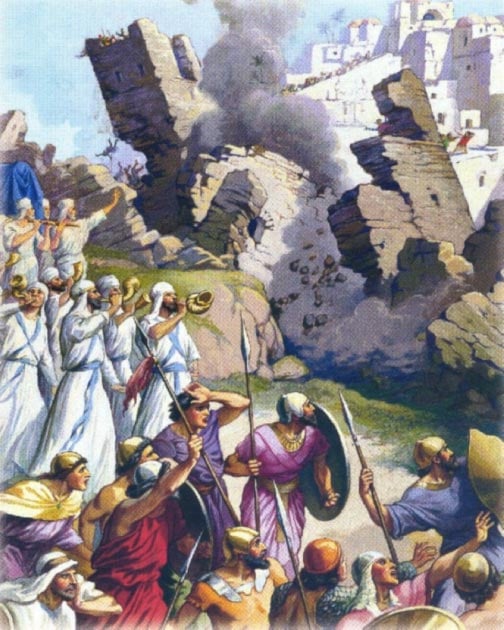
Biblical depiction of the fall of Jericho. (Otto Semler, CC BY SA 2.0)
The city of Jericho sat atop a mound or hill, which was surrounded by an embankment. The embankment was supported by an enormous stone retaining wall. Above the retaining wall was an 8-10 meter tall and 2 meter thick mudbrick wall. The wall was directly above the retaining wall and lined the edges of the embankment.
At the perimeter of the summit of the flat-topped hill on which the city was built was another mudbrick wall, which contained the upper city. There is evidence that houses were also built on the embankment and people lived on the lower part of the hill between the inner wall and the outer wall. Since this part of the city would have been less safe in times of war, it has been suggested that this was likely the poorer part of the city. The upper city may have been inhabited by the elites, while commoners lived in the lower city.
Although the inner and outer walls were only mudbrick, they would have been impressive for the time and would have made Jericho a mighty fortress to which people from surrounding towns and villages could flee in times of invasion.
Jericho and Bronze Age Fortifications
The city of Jericho appears to follow a Bronze Age tradition in which cities were built on top of artificial embankments or mounds surrounded by walls. This style of defense is found outside of Jericho at locations such Hazor, Megiddo, and Shechem. Typically, the site would consist of a mound with an artificial embankment surrounding it. Around the embankment would be a stone retaining wall. Settlements with this type of defense structure also had a mudbrick wall built atop the retaining wall as well as another wall surrounding the crest of the mound. This type of fortification is referred to as a glacis and is found all over Palestine and in large portions of the Middle East.
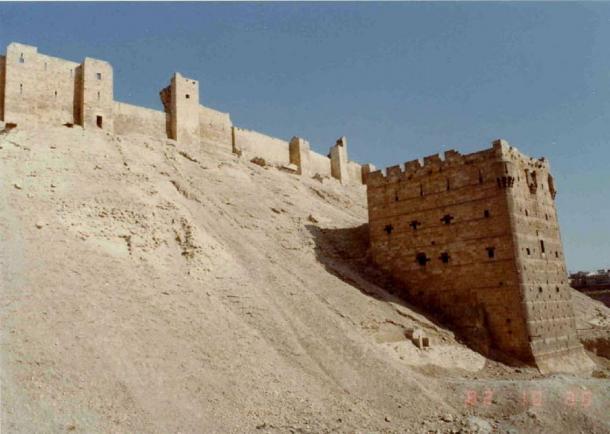
Citadel of Allepo, Syria, showing an example of a glacis fortification, 2007. (Brian Harrington Spier / CC BY-SA 2.0)
Scholars have speculated about the origin of the glacis. When research into these structures began in the early to mid-20 th century, these fortifications were originally associated with the Hyksos. Originally, the Hyksos were thought to be Indo-European chariot warriors. The fortification was postulated to represent the original fortifications that they used in their homeland.
Since the mid-20 th century, this theory has been abandoned and the glacis fortifications are no longer considered to be associated with chariot warfare. Today, the Hyksos are known to have spoken a Semitic language and were likely more closely related to the ancient Hebrews than they were to Indo-European steppe warriors.
Although archaeologists had abandoned the idea that the fortification design came from the steppes of the Indo-European homeland, they were still convinced that the fortification must have come from the north, such as from Anatolia or Syria. By 1968, archaeologists had begun to suggest that the glacis was a native design invented by the Palestinians themselves. This appears to be the predominant view currently.
Another point of contention has been the use of the fortifications. Archaeologists in the mid-20 th century, originally believed that the glacis-fortifications were primarily military forts. It is now known that they were simply fortified towns and that at their summits and on the embankments were houses, temples, and other civilian structures.
The glacis first came in to use in the late 18th century BC and was widespread through the middle Bronze Age. By the Iron Age, the glacis appears to have fallen out of use. The legacy of the glacis, however, is reflected in the mound or hill-shaped structure of many archaeological sites across the Levant.
- 11 OF THE MOST ANCIENT AND CONTINUALLY OCCUPIED CITIES IN THE WORLD
- HOW HUNGRY, HUNGRY HIPPOS STARTED A WAR IN ANCIENT EGYPT
The Walls of Jericho and Biblical Archaeology
For a while, Jericho presented a problem in Biblical studies. On a broader level, there appears to be a discrepancy between the account of the Israelite settlement of Canaan in the Book of Joshua and what is known from archaeology. An initial reading of the Book of Joshua gives the impression that Canaan was taken in a sudden conquest. This is not what is reflected in the current archaeological record that suggests a more gradual settlement, which is more consistent with the account given in the Book of Judges.
However, a closer reading of the Book of Joshua shows that not all of Canaan was conquered by Joshua. Only three cities were specifically described as being burned and destroyed by the ancient Israelites, Ai, Hazor, and Jericho.
As can be seen, evidence of a swift invasion is not necessary to reconcile the Book of Joshua’s account with the archaeological record. Nonetheless, the story of the destruction of Jericho, Ai, and Hazor, around 1400 BC, is consistent with what is known from archaeological excavations.
When the Bible speaks of the walls of Jericho falling down, the original Hebrew wording carries the idea of the walls falling “below themselves.” This is consistent with the design of the glacis since the outer wall would probably be a mudbrick wall sitting atop the stone retaining wall. Thus, if the outer wall was toppled, it would fall below to the base of the retaining wall.
During early archaeological excavations by the British archaeologist Dame Kathleen Kenyon, a stone retaining wall was found at the base of the tell associated with Jericho, but a mudbrick wall wasn’t found. However, a deposit of collapsed mudbrick was found at the base of the retaining wall at certain locations around the tell. This is surprisingly consistent with the account in the Book of Joshua. This collapsed wall would have also created a ramp for the Israelite warriors to march up the embankment to take the city. In this way, the archaeological record makes the Biblical account surprisingly believable. It supports the idea that the walls tumbled “below themselves” as well as the statement that the Israelites went “up” to take the city.
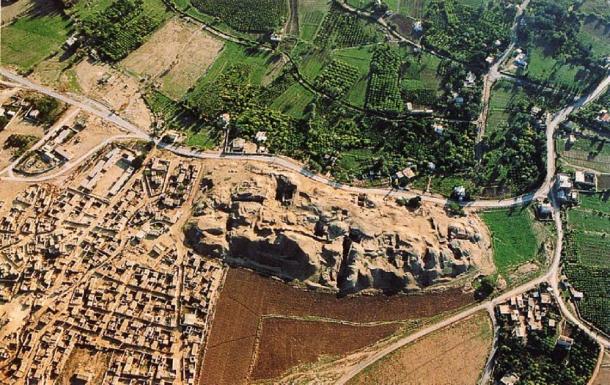
Birdseye view of the unearthed foundations at Tell es-Sultan in Jericho and the surrounding area, 2008. (Public Domain)
Another specific part of the narrative that is also made plausible by the archaeological record is the account of Rahab’s house being spared. In the Biblical narrative, two spies were sent into the city and they were harbored by a prostitute named Rahab. For helping the spies, Rahab was promised that she and her family would be spared when the city was destroyed. It is implied in the Biblical text, when the walls collapsed that her house was not destroyed even though it was connected to the wall.
During an early excavation in 1907-1909, German archaeologists found that, although most of the wall had collapsed, a portion of the wall had not entirely collapsed and appeared to have been preserved. They also found evidence that houses had been built along the wall. These houses typically had a thickness of only one brick, suggesting they were built for the poorer inhabitants of the city. Although this may not have been the location of Rahab’s house, it is consistent with the Biblical narrative.
Another detail that is also of interest in the archaeological site of Jericho is the presence of pots of charred grain that were burned from when the city was attacked and destroyed. What is unusual about these grain pots is that grain would probably have been eaten during a siege if it had been prolonged over a long period of time. The siege of Jericho by the ancient Israelites is said to have lasted only seven days. The fact that the grain pots were still full is consistent with a short siege. This also supports another part of the Biblical narrative, which mentions that the battle of Jericho happened in the spring, shortly after harvest time.

Biblical depiction of the battle of Jericho. (Public Domain
Implications for the Biblical Narrative
These details do not prove that the Bible is true necessarily, but they do demonstrate that the Biblical narrative is plausible and makes sense. This is consistent with other archaeological finds that increase confidence in the Biblical narrative as being at least archaeologically and historically realistic.
Although there are still unanswered questions and discrepancies between the Biblical account and the archaeological record, the Bible can be thought of as a basically reliable document that does provide some useful details for archaeologists and historians interested in understanding the lifeways and societies of the ancient Levant, even if it turns out to not be true or accurate in its entirety.
An analogy is Homer’s Iliad. The archaeological site now considered to be the site of ancient Troy was first excavated by Heinrich Schliemann in the 1870s. Schliemann was in search of the Troy of Greek legend. During this excavation, Schliemann discovered artifacts, which he believed to be the treasures of King Priam, although this idea was later discredited. Nonetheless, in the century and a half since the initial excavations by Heinrich Schliemann, scholars have noted that the topographic descriptions of the land and city in the Iliad do seem to match what is known of the ancient city from archaeology. This is interesting in light of the fact that Hisarlik, the current Turkish name for the archaeological site, has been associated with the legendary city for thousands of years. Although it is far from clear how much of the Trojan war is history and how much is legend, it does appear plausible that there is truth to the narrative.
The Ramayana is another possible example. Although Rama, the main character, is not mentioned on any monuments or coinage, as would be expected of a historical monarch, most of the cities and places mentioned in the Ramayana are known to exist or have been discovered through archaeological investigation. This does not necessarily mean that the events in the Ramayana happened as described, but they do make the story of the Ramayana more plausible.
In the same way, these archaeological findings at Jericho do not necessarily prove that the Biblical narrative happened exactly as described, but they do lend credence to the story described on the pages of the Bible. Although sometimes archaeology casts doubt on traditional stories about the past, other times it confirms them in surprising ways.
Top Image: Bible Old Testament: Joshua and the walls of Jericho. Source: Archivist / Adobe Stock
By Caleb Strom
References
Hirsch, Emil G., M. Seligsohn, and Solomon Schechter. 1895. Jericho. Jewish Encyclopedia.
Available at: http://www.jewishencyclopedia.com/articles/8597-jericho
Hirst, K. Kris. 2019. Jericho (Palestine) – Archaeology of the Ancient City. ThoughtCo.
Available at:
https://www.thoughtco.com/jericho-palestine-archaeology-of-ancient-city-171414
Jarus, Owen. 2017. Ancient Troy: The City & the Legend. Live Science. Available at:
https://www.livescience.com/38191-ancient-troy.html
Jewish Virtual Library. N.D. Jericho. Available at:
https://www.jewishvirtuallibrary.org/jericho
Kenyon, Kathleen. 1954. Excavations at Jericho. The Journal of the Royal Anthropological
Institute of Great Britain and Ireland. Available at: https://www.jstor.org/stable/2844004
Kenyon, Kathleen. 2017. Jericho. Encyclopedia Britannica. Available at:
https://www.britannica.com/place/Jericho-West-Bank
Parr, Peter J. 1968. The Origin of the Rampart Fortifications of Middle Bronze Age Palestine
and Syria. Journal of the German Palestinian Society. Available at:
https://www.jstor.org/stable/pdf/27930822.pdf
Strom, Caleb. 2017. Was Rama Based on a Real Historical Figure? Ancient Origins.
Available at:
https://www.ancient-origins.net/myths-legends/was-rama-based-real-historical-figure-007456
Windlebry. 2019. Biblical Sites: Three Discoveries at Jericho. Bible Archaeology Report.
Available at:
Wood, Bryant. 1999. The Walls of Jericho. Creation Magazine. Available at:
https://answersingenesis.org/archaeology/the-walls-of-jericho/
Related Post
A shocking documentary proves that mermaids do exist
SHOCKING Revelation: Thuya, Mother of Queen Tiye, Was the Grandmother of Akhenaten and Tutankhamun—What Ancient Egyptian Secrets Did She Leave Behind?
Breaking News: Astonishing Discoveries at Karahan Tepe Confirm an Extraterrestrial Civilization is Hiding on Earth, and NO ONE Knows!
Breaking News: Researchers FINALLY Discover U.S. Navy Flight 19 After 75 Years Lost in the Bermuda Triangle!
NASA’s Secret Investigation: Uncovering the Astonishing Mystery of the UFO Crash on the Mountain!
Explosive UFO Docs LEAKED: Startling Proof That Aliens Ruled Ancient Egypt!